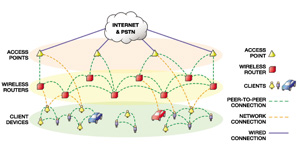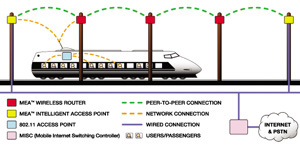Population Density and Wireless Networking
Back to Contents of Issue: September 2004
|
|
|
|
by Allen H. Kupetz |
|
 MANY PEOPLE retain a perception of peer-to-peer networking based on the old Napster model of file sharing. While that model offers the advantage of lots of users, there is no benefit to having lots of users in close proximity (i.e., high population density). MANY PEOPLE retain a perception of peer-to-peer networking based on the old Napster model of file sharing. While that model offers the advantage of lots of users, there is no benefit to having lots of users in close proximity (i.e., high population density). But wireless peer-to-peer networking -- networks using devices that serve as both transceivers and routers for other devices -- is gaining broad acceptance in many different vertical markets, including public safety, mass transit and intelligent transportationsystems. And, not surprisingly, it is the more densely populated cities in north Asia like Beijing, Seoul and Tokyo that are among the earliest adopters of this technology. Increased bandwidth and decreased deployment costs are the reasons that north Asia is again at the leading edge of a new wireless technology. "... I began to notice people on the streets of Tokyo staring at their mobile phones instead of talking to them. The sight of this strange behavior, now commonplace in much of the world, triggered a sensation I had experienced a few times before -- the instant recognition that a technology is going to change my life in ways I can scarcely imagine. Since then, the practice of exchanging short text messages via mobile telephones has led to the eruption of subcultures in Europe and Asia É. Adolescent mating rituals, political activism and corporate management styles have mutated in unexpected ways." -- Howard Rheingold (Smart Mobs) How it works............................................ Wireless peer-to-peer networking, sometimes called "fourth generation" (4G) wireless, was originally conceived by the US Defense Advanced Research Projects Agency (DARPA), the same organization that developed the wired Internet. It is not surprising, then, that DARPA chose the same distribution architecture for the wireless Internet that had proven so successful in the wired Internet. Peer-to-peer networks eliminate the spoke-and-hub weakness of cellular architectures, because the elimination of a single node does not disable the network -- just as the loss of a single router does not disable the wired Internet. Because users carry much of the network with them, network capacity and coverage are dynamically shifted to accommodate changing user patterns. As people congregate and create pockets of high demand, they also create additional routes for each other, thus enabling additional access to network capacity. Users will automatically hop away from congested routes to less congested routes. This permits the network to dynamically and automatically self-balance capacity, increasing network utilization. Furthering the economic argument is the 80/20 rule. With traditional wireless networks, about 80 percent of the cost is for site acquisition and installation, and just 20 percent is for the technology. Rising land and labor costs mean installation costs tend to rise over time. With wireless peer-to-peer networking, however, about 80 percent of the cost is the technology and only 20 percent is the installation. Because technology costs tend to decline over time, peer-to-peer networking will become less and less expensive to deploy.  Back to the future...................................
Back to the future..................................."When a distinguished and elderly scientist says something is possible, he is almost certainly correct; when he says something is impossible he is very probably wrong." -- Arthur C. Clarke Sam Joseph was correct in several of his predictions, most importantly, the notion that "the population density of a city can suddenly become a blessing instead of a curse." In cellular networks, users compete for a finite number of channels. Irrespective of the size of the cell, the n+1 user gets no coverage. In peer-to-peer networks, users cooperate instead of competing -- they provide alternative paths to other users when the shortest (i.e., fewest number of hops) or fattest (i.e., highest throughput) path is not available at that moment. Joseph also correctly noted that "centralized approaches ... are not likely to scale indefinitely." Dr. Keiji Tachikawa, CEO of NTT DoCoMo, said in January of this year that "by 2010, only 1/5 of DoCoMo's users will be human beings. The rest will be cars, bicycles, computers, ships, vending machines and home appliances." While even experts still disagree as to what the final definition of "4G" will be, it is becoming increasingly obvious that the cellular architectures designed for 1G are not going to be able to provide an adequate number of users (human and non-human) with the amount of bandwidth they will demand in the future. Other challenges Joseph identified now have solutions. The concern that "you might end up not being able to use your own phone because two of your friends are using it to talk to each other" has been solved. MeshNetworks, one of the two companies mentioned in the original article three years ago, uses four data channels. One channel is a common overhead channel shared by all users in the vicinity, which leaves three other channels available either for the user or for other users. More broadly, the whole notion of population density (or lack thereof in off-peak hours) has also been solved. Although wireless peer-to-peer networks can be ad hoc (infrastructureless), MeshNetworks' solutions also provide for wireless routers to be deployed and given priority in routing algorithms. This means that in normal (day-to-day/non-disaster) situations, users will have the benefit of coverage and capacity of infrastructure (see Diagram 1). But in post- disaster scenarios, first responders with peer-to-peer products will have the ability to communicate with each other, as opposed to non peer-to-peer devices that would be useless.  Today's wireless world.............................
Today's wireless world.............................Arguably the biggest change since Joseph's article was published in 2001 is the tragedy of 9/11 and the growing number of terrorist incidents -- especially those targeting mass transit. While Japan suffered from the horror of the Aum Shinrikyo subway poison gas attacks in 1995, the 2004 attack on the trains in Madrid show the potential for even greater loss of life. And since north Asia's densely populated cities are much more reliant on public transportation than most Western cities, a terrorist act -- or even an accident, like the subway fire in Taegu, South Korea, in 2003 -- would have a devastating impact. Unfortunately, no technology can eliminate terrorism or mass transit accidents, but peer-to-peer networking can enhance public safety. There are several trials currently underway in China, Hong Kong, Japan, South Korea and Taiwan to provide real-time streaming video from trains, subway cars and buses. Real-time monitoring, previously not possible because of the bandwidth requirements at speeds approaching 200km/h, offers the hope of being able to preempt terrorist attacks and enhance mass transit safety. And the same system can be shared by riders to obtain 802.11 "mobile hot spot" access (see Diagram 2) using peer-to-peer technology. Sam Joseph made several bold predictions in 2001, so I will try to do the same. By 2007, wireless ad hoc peer-to-peer networks will be the standard for data networks. The IEEE will have adopted one or more mobile broadband data standards to allow for the mass production of components. Asia will have the largest deployed mobile data networks, with Korea and Japan being the first to roll them out on a nationwide level. Cellular architecture will still be the dominant standard for voice networks. And the US, still not having granted 3G licenses, will decide to skip a whole generation and go directly to 4G. You heard it here first. See you in three years. @ |
|
Note: The function "email this page" is currently not supported for this page.





